Launched in 1988, New Zealand Musician was the last local music magazine standing when it stopped regular print runs in 2017. It continues online and through bi-annual issues, with the same mission it had from the start: speaking directly to musicians about the skills, gear, and knowledge they need to survive in the industry.
Plenty of big acts have graced the cover, but the magazine has always made an effort to cover young acts or artists from genres that are less in vogue, giving coverage to talents that might otherwise be overlooked.
Given that the magazine is such an institution within the local scene, it’s ironic that it was started primarily by two Australians, Alex Bolt and David Hines. They were music-instrument importers seeking a new way to market their products, so they decided to create a magazine that focused on gear, while also providing useful information for musicians.
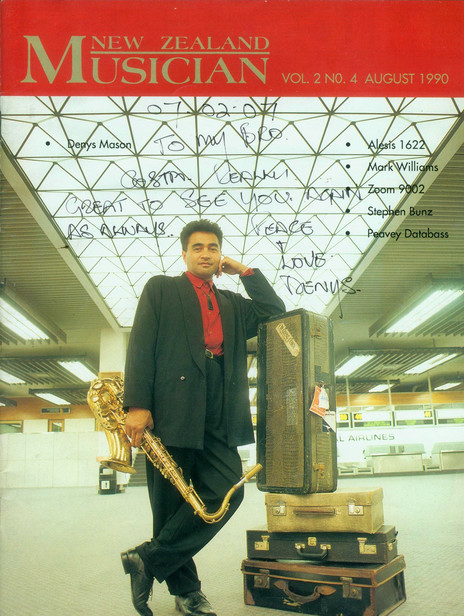
Denys Mason on the cover of New Zealand Musician, August 1990.
For the initial issues this meant the magazine wasn’t particularly focused on the local scene and the first cover was of English session drummer Simon Phillips (Toto, Jeff Beck, Mick Jagger, etc). Inside were half-a-dozen reviews of state-of-the-art instruments that now sound like quaint throwbacks: the Casio DA-1 Portable DAT Recorder, the Atari Recording System, the Ensoniq keyboard.
Over the next few issues, the magazine slowly became more interested in the local scene with Dave Dobbyn appearing on the second issue (October 1988), though Mick Jagger’s surprise gig at The Gluepot appeared on the third. However, NZ Musician was already losing money and its future was in jeopardy.
Alongside the two Australian owners, NZ Musician was also supported in the background by the owner of the Auckland Rockshop, Mick Webb, though his name wasn’t included on the masthead. His brother-in-law, Richard Thorne, had just returned from travelling in Europe and was looking for work, so Webb asked whether he might be keen to take on running the magazine.

Richard Thorne, editor and publisher of New Zealand Musician magazine, c. 2004. - NZ Musician collection
Thorne was somewhat of an odd choice, since he had no experience in journalism and wasn’t a musician, describing himself more as an avid music fan and long-time hi-fi buff. What Thorne did have going for him was a drive to succeed in this new career and he put every ounce of his energy into ensuring NZ Musician’s survival. The learning curve was steep and unrelenting.
The process for getting the magazine printed in 1989 was complex enough, with the layout of text, titles and images glued on cardboard sheets before they could be scanned for printing. In those early years, Thorne also had to do much of the writing and photography. He learnt the potential pitfalls from his very first issue.
Given its evident focus on instruments rather than music, record label publicists initially showed little interest in NZ Musician. EMI rep Dianne Moffatt was supportive, giving Thorne the opportunity to interview and photograph Crowded House for what would be his first issue. He committed to putting Crowded House on the cover before receiving the prints of his shots from the live show. Unfortunately the internal mirror on his camera had been damaged while he was travelling and the majority were too dark to use. With no other choice, he picked the best three and laid them out in a manner mimicking the Temple Of Low Men album cover to disguise their failings.
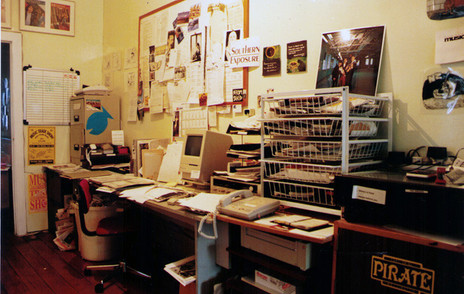
The magazine's office on Karangahape Road, Auckland, c. 1990 - NZ Musician collection
For each issue, Thorne also needed to take photos of instruments that were being reviewed, since the New Zealand importers seldom had any to provide. The instruments would be laid out on sheets, but unwanted shadows often meant the need to clear-cut the instrument out of the photo with a scalpel so it would look right, or fit on the page (guitar tuning pegs were particularly finicky).
The magazine gradually found its feet and Thorne slowly pushed it in the direction he thought it needed to go, with more local artists featured and less of a technical bent, so it could be read by everyday music lovers. However – due to high studio costs – local releases were scarce in the early 1990s, and given its bi-monthly publishing schedule, local labels often failed to give notice of those albums that were coming out.
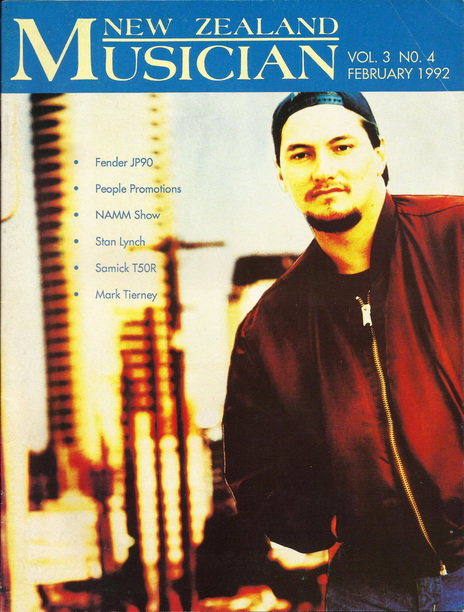
Mark Tierney on the cover of New Zealand Musician, February 1992.
Thorne solved this problem by doing a series of independent record label profiles, which not only gave the magazine a focus but also introduced him to the main players in the industry. This led to covers that featured label heads such as Trevor Reekie from Pagan Records and Southside Records’ Murray Cammick and Simon Lynch. Another short-lived idea was to have a “band profile form” that acts could fill out to appear in the magazine ; this opportunity that was taken up by covers bands and newly emerging acts like Whiskey N’ Lace and Gitbox Rebellion, before the magazine was too inundated with applicants to continue this feature.
Fortunately the magazine already had some talented musician contributors onboard, among them Bruce Morley (who had been a full-time drummer since the early 1960s), and Hotcake pedal creator and early Split Enz drummer Paul Crowther. Others offered their untrained writer services or were cajoled to contribute, but Thorne admits leaving his name off some of his own articles so it was less obvious how much of the magazine he was writing.
In August 1989, a planned cover story about the Rheineck Rock Awards came badly unstuck when his car was broken into and thieves stole a briefcase which included the tapes used to record interviews with many of the finalists. With no time to change tack or repeat interviews before the print deadline, Thorne cobbled together a shorter piece with the aid of Morley.
Another early near-disaster occured when the most lucrative advertisement spot (the back cover) had been incorrectly printed, so the black and white keys of a keyboard were transposed. Frantic discussions with the printer led to them reprinting and re-stapling the cover, but from then on Thorne says he made sure he was present at the print factory when the first sheets came off the press (at least, until digital technology made such errors less likely).
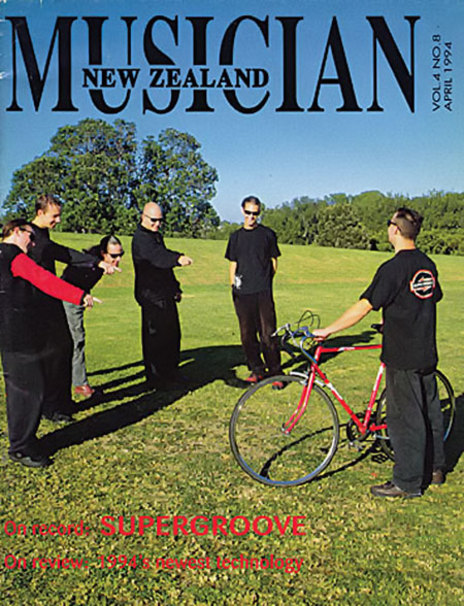
Supergroove on the cover of New Zealand Musician, April 1994
Running the magazine almost single-handedly was becoming a 60-hour-a-week job and Thorne found himself exhausted by endless nights of staying up until the early hours finishing articles and cutting and pasting the layouts:
“The owners first wanted to claw back their investment, so my wage was set at a low enough level that a small profit would ensure they got their money back. Within six months that had happened and I gave them an issue or two beyond that to see if they’d offer me a raise. When they didn’t, I presented three options to them: 1. was that I give up the job and they could carry on without me; 2. was that they markedly increase my pay and we’d carry on as normal; or 3. that they could give me or – at worst – sell me the magazine.”
The owners agreed to sell and this led to the June 1990 issue listing Richard Thorne as both editor and publisher, two titles that he would hold from that point onward.
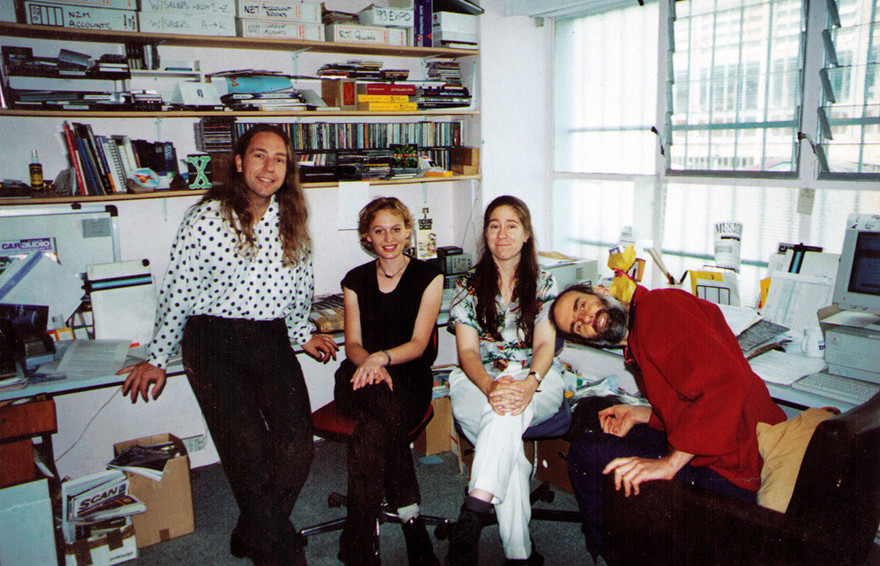
The New Zealand Musician magazine team, c. 1993. From left: Richard Thorne, Milly Olykan, Alice Shopland, and Russell Shipman (designer). - NZ Musician collection
Thorne knew that there was no point competing with other music magazines in the market, particularly the long-running rock monthly Rip It Up. It was an early decision for NZ Musician to open itself to a broader range of music styles by covering folk, country, jazz, and blues acts who were unlikely to be profiled elsewhere:
“Coming in naive and new to the scene, I was surprised how dismissive some musicians could be about music outside their own genre. For instance a rock musician might have no knowledge of or respect for a jazz musician, or an equally accomplished folk artist. Hence my enthusiasm to put people like Nigel Gavin or Brendan Power on the cover, even though playing a boxy acoustic guitar or harmonica wasn’t exactly fashionable. Even someone like Nathan Haines – jazz wasn’t much in fashion when he was starting out.”
Harmonica player Brendan Power also joined a line-up of skilled musicians who contributed columns about their instrument, alongside drummer Frank Gibson Jr and bassist Kenny Pearson. It was a heavy blow when Pearson died suddenly – hit by a drunk driver as he drove home from a gig in 1992 – and Thorne marked his passing by putting Pearson on the cover.
Thorne didn’t want the magazine to be pigeon-holed in any particular style.
Thorne didn’t want the magazine to be pigeon-holed in any particular style, and NZ Musician also featured many of the big Flying Nun acts of the early 90s, including The Chills, Straitjacket Fits, The Bats, The 3Ds, and Bailterspace. They were given just as much space as country artist Glen Moffatt, blues player Ted Clarke, singer-songwriter Derek Lind or jazz act Nairobi Trio. Pop star Margaret Urlich featured on an early cover as did Moana Maniapoto. There were occasionally overseas musician interviews too, but only if they were seen as “musician’s musicians”, such as Steve Vai, Thurston Moore, Steve Harris (Iron Maiden), Buddy Guy, Stanley Youngman (drummer for Tom Petty’s Heartbreakers), and Joe Satriani.
As the magazine sought to grow the workload continued to be increase, as Thorne recalls:
“At the worst stage, I was living in a level-one flat on K Rd with a very skinny stairwell. The boxes of printed magazines would be dropped on the footpath and I would have to carry them all the way upstairs, take them all out, put them into envelopes etc, put them back into boxes, and then carry them all back downstairs again so I could deliver them to shops or the post office in my car. It was completely ridiculous but my flat was my office for years.”
It was a relief in late-1993 when there was finally enough money coming in to hire a part-time assistant editor. Alice Refiti Shopland had experience as a newspaper journalist and with musical styles changing rapidly at that point in time, having a young enthusiastic assistant editor was helpful. Shopland’s first issue was October 1993 and by early the next year the magazine had young stars Supergroove on the cover, along with articles about rising hip hop acts Urban Disturbance and 3 The Hard Way. Shopland also interviewed the Fuemana brothers for a cover story in June 1994.

The Fuemana brothers, New Zealand Musician, June 1994 - Photo by Greg Semu
By 1995, NZ Musician was doing profiles of five to six local acts per issue. Among the contributors were some of the most adept musicians to have come out of New Zealand, whether it was drummer Luke Casey writing about Eye TV’s tour of the US, Mark de Clive-Lowe discussing the birth of jazz discussion groups on the internet or Greg Johnson discussing his favourite Australian trumpeter. This was a local New Zealand magazine that was largely by musicians, for musicians.
NZ Musician gained a second staff member in August 1995. Thorne had met Melinda (Milly) Olykan at music industry events, through her work with Ode Records and Deepgrooves, and knew she was motivated. Olykan came on board as an assistant with Shopland, before handling the advertising for six months, then becoming assistant editor with the role expanded to become full time.

The NZ Musician magazine team in 1996 (from left): Dominic Blaazer, Russell Shipman, Milly Olykan, Andrew Polson, and Richard Thorne. - NZ Musician collection
Olykan recalls that the office used Apple Mac computers. This meant that if contributors brought their articles in with floppy discs from a PC they had to be converted before the Macs would recognise them. Having Olykan on board meant Thorne had time for other projects he’d started to supplement his editor’s income. In 1995 he started publishing a second magazine, New Zealand Car Audio, and also ran trade expos.
The surprising thing with a free magazine is that you never know who is reading it. In one case, an article by local guru Simcha Delft extolling the virtues of vintage amps ended up in the hands of the CEO of Peavey in the USA, who wrote a long reply explaining why modern amps could be just as good if made right.
During the late 90s, NZ Musician had its first part-time staff who were themselves musicians: guitarist Mark Bell (Blam Blam Blam, Coconut Rough) and keyboardist Dominic Blaazer. It was Blaazer who came up with the magazine’s rumours column, Out On The Street, and his band at the time, The Hitlist, graced the cover in August 1998.
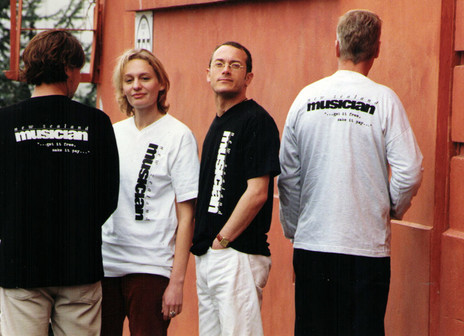
Modelling the New Zealand Musician merchandise in the 1998 season are Tony Richards (designer), Milly Olykan, Dominic Blaazer, and Mark Bell. - NZ Musician collection
Thorne gradually began to see that the magazine needed to go beyond just giving advice on musical technique and actually provide other knowledge that was required for musicians to survive. This stretched back to the magazine’s first legal columns started by Malcolm Black in 1992, and by the late 90s seemed more important than ever:
“The landscape had changed and a degree of professionalism was now going to be beneficial, since there were opportunities for people to make money if they knew what they were doing. APRA was less proactive at that time and we became so frustrated at the indifference that RIANZ showed to building the local scene that we started our own NZM public seminars to upskill local musicians.”
The first event brought together experienced figures such as Kirk Harding, Chris Hocquard, and Jairsino Wahid. Within a year, the local industry was indeed big enough that NZ Musician started an annual studio and label directory.
After four years with the magazine, Olykan finally left in January 1999 and went on to an amazing career in the international music industry. She became the Festivals and Events Director at the O2 (London) and then Vice President of International Relations and Development at the Country Music Association of America. She says she gained a lot from her years at NZ Musician:
“I loved working for Richard. Over the years he gave a number of talented women a great start in the music business. We got to attend every awards ceremony and press conference so had access to everyone we wanted to in the business ... It was the first time I felt trusted by a boss, particularly to take time and be creative. I will always really appreciate Richard for that. He empowered me in my mid-twenties and it gave me a lot of confidence. I’ve passed that on in my career by standing back and making space for junior staff to feel they are in a healthy environment to learn.”
Olykan was replaced by a graduate from the AIT (now AUT) journalism course, Jennifer Scott. It was Scott who solved one problem that had bothered Thorne since the magazine had started: the inability to cover drum equipment properly. Importers couldn’t justify providing review kits to a publication like NZ Musician – the drumheads would soon wear and be costly to replace, and the time investment for any reviewer would be substantial.
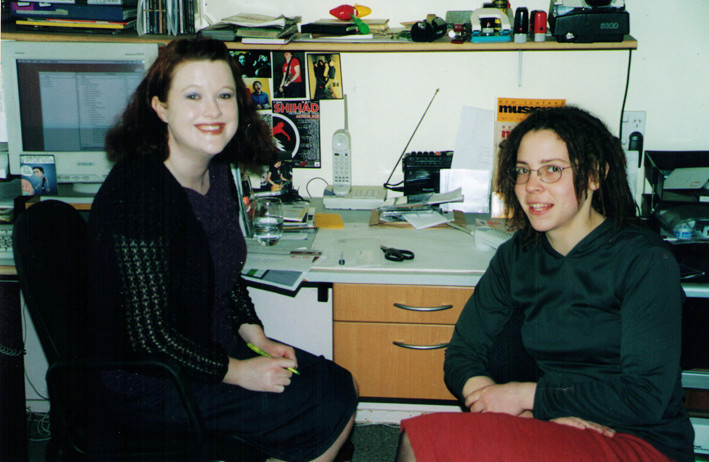
Jennifer Scott and Emma Philpott of New Zealand Musician magazine, c. 2002. - NZ Musician collection
Scott helped come up with the idea of having local active drummers on the scene talking to each other about their drum kit set-ups and suggested the name, “Get Yer Kit Off”. In the early years, the column featured such drummer-combinations as: Tom Larkin (Shihad) interviewed by James Kage (Polaar), or Tony Hopkins interviewed by Luke Casey, or Andrea Holmes interviewing Brendan Moran (The Hasselhoff Experiment, The Subliminals).
Another new aspect of the magazine was its website, which Thorne arranged via an unexpected collaborator. “I was being interviewed on bFM and mentioned we were looking at developing a website. Within a day or two, Murray Fisher from Goodshirt got in touch and said ‘I design websites, would you like me to make one for you?’ It was great because I was a huge Goodshirt fan and he was obviously a musician so could guide the design, plus he was aware of the need to keep costs reasonable.”
That same year (2000) NZ Musician started its Fresh Talent section, devoting a half-page each to three-four upcoming acts on the scene. It reflected a burgeoning local music scene, allowing the magazine to give coverage to more, less proven acts. Many of them eventually became big enough to feature on the cover of the magazine, including Blindspott, Nesian Mystik, Kora, and Die! Die! Die! (who also appeared in an early incarnation as Carriage H).
In December 2000, NZ Musician celebrated its 75th issue and was printing nearly 10,000 copies per issue. The following year, they found a new way to support new acts by starting the Ovation songwriter competition in collaboration with the NZ Rockshop chain. Around this time, Jennifer Scott departed as assistant editor and was replaced by Emma Philpott who’d been working for Loop magazine in Wellington.

Pitch Black, New Zealand Musician, August/September 2000
Writer and dub musician Peter McLennan (Hallelujah Picassos) also worked with the magazine to launch Freq:NZ, an editorial section focused on the new dance music and hip hop movement.
“NZ Musician had been established for over 10 years, but now there was this new musical form that was appealing to a largely different audience. We wanted to be part of that discussion, but questioned whether it would work to just scatter this new turntable and sampler-based content throughout each issue. By treating it as a separate section, it would allow us to grow it if the advertising support warranted. Turns out that area of music was dominated by a quite small number of brands, and each of them only ever wanted one ad, so in the end Freq:NZ had a limited lifespan.”
Nonetheless, the section lasted until 2005 and brought on new writers such as Sir-Vere and Stephen Jewell. In the meantime, Emma Philpott had been replaced as assistant editor by Melanie Selby, who was very active in representing NZ Musician at industry events and did a great job of keeping her ear to the ground for new trends. The importance of the magazine’s website was now at the point where it required someone to look after it, and Renee Jones was hired as the first website manager in February 2005.
Meanwhile, Thorne had taken on a new role at the New Zealand Music Industry Commission (starting in August 2003). He’d been approached by Arthur Baysting to become chairman of the NZMIC’s board of trustees, and held this role for five years.
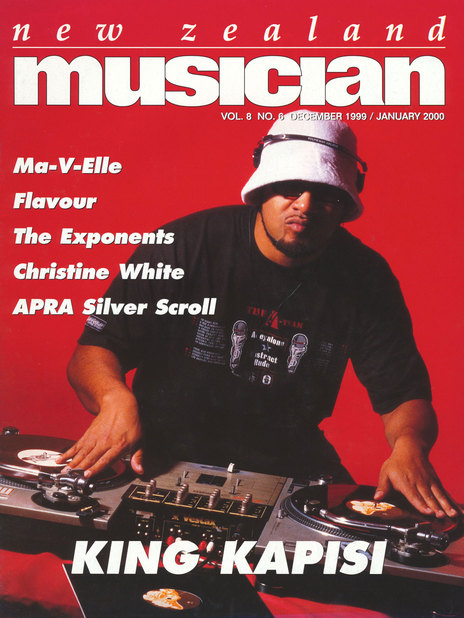
King Kapisi, New Zealand Musician, January 2000
One of his major accomplishments as chair was helping with establishing the Outward Sound scheme, which provides funding support for local acts taking their music overseas. He also came up with the “Outward Sound” name. His tenure also saw the Music Commission become established as a fixed item in future government budgets, meaning the organisation no longer had to apply for funding year-upon-year.
Back at NZ Musician, more changes were afoot with Lydia Jenkin taking the assistant editor role in mid-2007. She stayed for over four years, before becoming a music writer at the NZ Herald and then taking a role at APRA. Over this time, one of the magazine’s most enduring columns had also been introduced: Moments Like These. It presented a historical photograph of local musicians and had one of those present give some insight into the time. Initially published sporadically, the column was given gravitas when it was taken over by Trevor Reekie.
Reekie enjoyed the chance to give back to a magazine that had been hugely supportive of the acts on his labels: “I’ve always maintained a close relationship with NZ Musician magazine as it’s a crucial vehicle to developing and maintaining a profile for local artists and getting a bit of love in the process. The mag has a good profile so always gave my Pagan and Antenna artists significant attention. Its distribution to record stores, schools and educational institutions made it a highly relevant destination to a suitable audience. Aotearoa would have been musically poorer by its absence. NZM’s legacy in the local music fraternity is assured.”

Editorial meeting, 2013: Amelia Murray, Silke Hartung, Richard Thorne, and Stephen Heard (web manager). - NZ Musician
From 2011 to 2014, there were four more assistant editors, each of whom would go on to be active in the arts: Ren Kirk (later became Arts and Culture Content Manager at Auckland Council), Westley Holdsworth (a solo artist), Amelia Murray (Fazerdaze), and Anna Loveys (publicist at Sony and her own company, Saint Lachine). Silke Hartung came on board as a designer in 2010 and by August 2014 had taken on the assistant editor role.
Amelia Murray went on to have international success as Fazerdaze with millions of Spotify streams (10 million for her song ‘Lucky Girl’ alone) and she recalls that her involvement with NZ Musician came at a foundational time in her life:
“Having relocated to Auckland in 2012 to study music, I was excited to discover the NZ Musician office was only a few doors away from my new flat. I’d read the magazine since high school so I mustered up the courage to introduce myself to whoever was behind that door. Richard and Silke welcomed me in and I quickly became part of the small team as intern, and a few months later, assistant editor. Working in that office surrounded by music – listening to not-yet-released albums, discovering local artists and organising interviews – was thrilling for 19-year-old-me and I was happy to let my uni grades slip just to be part of it all … There’s no doubt that my time there gave me plenty of encouragement, fuel and industry contacts to launch Fazerdaze.”
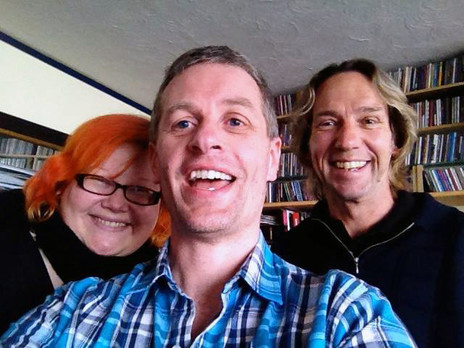
An office selfie, October 2014: Silke Hartung, Bing Turkby, Richard Thorne. - NZ Musician collection
The most enduring presence around the NZ Musician offices in the 2010s was Hartung. This was at a time when all print magazines were struggling to survive and 2015 saw the demise of long-running local music magazine, Rip It Up.
Thorne says the main thing that had kept NZ Musician viable over the previous decade had been the reducing costs of design and printing the magazine due to advances in digital technology. It had been a while since the magazine had been able to afford to employ freelance writers and over time there was no money available for part-time assistants either. By 2016 Thorne and Hartung were running the magazine and its website as a team of two, reliant on unpaid contributions from supportive writers. Thorne was left with a hard decision to make:
“As things became tighter financially, with advertising declining year on year due to the internet effect, it was harder to see a future for the magazine. In acknowledging that, I had two options: I could close it down and find another job, or I could keep it running and go get another job. I didn’t want to wind it up just because it wasn’t making enough to meet my needs financially, given that it was employing somebody and giving others the opportunity to write – not to mention the readership. There’s also the legacy of information and history built up over that time in our archives, and I know each issue still delivers considerable value for both readers and advertisers.”

A New Zealand Musician gathering, August 2014. From left: Amelia Murray, Richard Thorne, Stephen Heard, Martyn Pepperell, Michael Cathro, and Silke Hartung. - NZ Musician collection
Thorne had spent the previous few years preparing for this eventuality by developing the NZMusician.co.nz brand and a newly designed website that would be modern enough to stand alone in place of the magazine. Once this work was completed, he hit pause on the print magazine while deciding on a publishing schedule that might be financially viable.
April/May 2017 was the last regular bi-monthly issue and it nodded to the recent history of the magazine by featuring two acts with members who had worked at the magazine: Fazerdaze and Clap Clap Riot (band member Stephen Heard had been a part time employee). The impressive illustration on the cover (by Indium Design’s Barny Bewick) suggested that NZ Musician was dead as a physical magazine, but the website would live on. However, Thorne made it clear in his editorial that they would continue to print occasional issues.
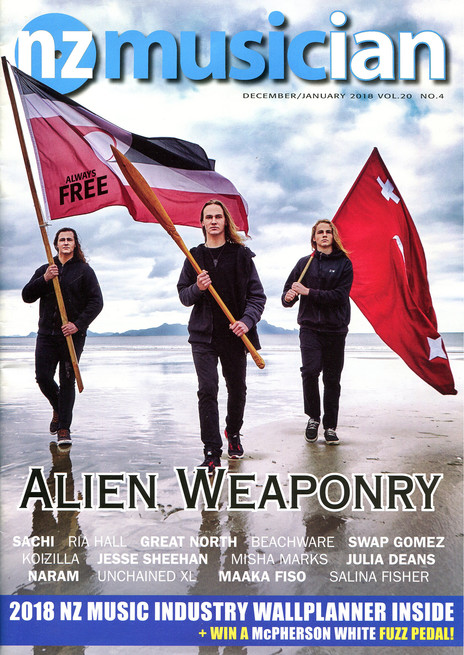
Alien Weaponry, New Zealand Musician, Dec/Jan 2018. - Photo Maryanne Bilham
After a six-month break, the physical magazine was back in stores once more, but had switched to a twice-yearly schedule. A run of fresh artists graced the cover over the years that followed: Alien Weaponry, Estère, Chelsea Jade, Soaked Oats, Troy Kingi ...
Over three decades since its first issue, the mission of NZ Musician remains the same: promoting new local music to New Zealanders, encouraging and supporting our musicians early in their careers, and allowing a diverse range of acts to see themselves in print, often for the first time. The magazine has consistently provided a regular snapshot of what is happening across the breadth of the country’s ever-developing music scene. In the interim, the publication has become an institution among musicians and its remarkable contribution to the local scene continues to this day.
--